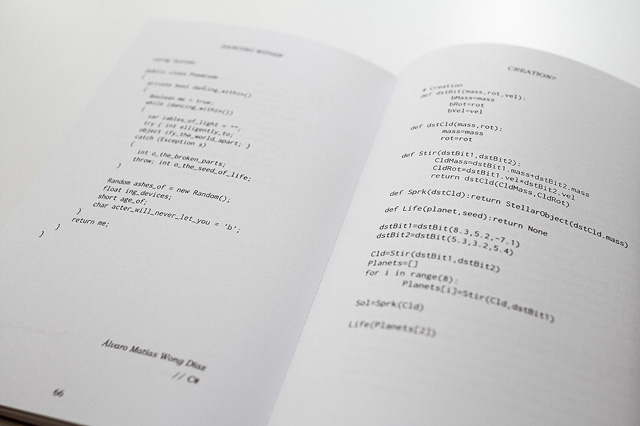Meu Deus! Quanta violência! Será que ele morreu?
Shared posts
A pior cena de atropelamento de todos os tempos
Meu Deus! Quanta violência! Será que ele morreu?
OpenOffice Is Now, Officially, Apache OpenOffice
Read more of this story at Slashdot.
Flu Shots May Not Protect the Elderly or the Very Young
Every year around this time, 120 million Americans roll up their sleeves to get their annual flu shots. Since 2010, the U.S. Centers for Disease Control and Prevention has recommended yearly jabs for every healthy American over the age of six months. The goal is to curb the spread of infection and minimize the risk for potentially dangerous complications such as pneumonia, particularly among the elderly and the very young. But science on the vaccine’s efficacy is scant among those two vulnerable groups. And although healthy adults do get some protection, it may not be as robust as they expect.
[More]Os Caça-Fantasmas 3 deve ser filmado na metade de 2013
Toda vez que eu vejo isto, tenho certeza que o ônibus espacial vai perder uma asa
Olha só este GIF animado. É o momento mais difícil para o ônibus espacial Endeavour, que andou por Los Angeles rumo a seu local de aposentadoria permanente, no Centro de Ciências da Califórnia.
Estes GIFs vieram do timelapse espetacular que o LA Times preparou sobre a última jornada do Endeavour. E a última foi uma das mais loucas.
Não só o ônibus espacial teve de enfrentar a multidão, como precisou passar por lugares muito apertados. Em alguns momentos, ele quase tocou em árvores e casas. Foram os momentos mais tensos.
Para ter uma ideia melhor, eis uma foto de longe:
A Endeavour foi o penúltimo ônibus espacial a decolar da Terra, e o penúltimo a voltar. A Atlantis foi a última.
Ver isso me deixa um pouco triste. Aproveite a aposentadoria, Endeavour. Você passou por 25 lançamentos perigosos, levou 154 pessoas para o espaço, voltou em segurança e ainda completou a façanha mais perigosa de todas: sobreviver ao trânsito de Los Angeles.
O vídeo não pode ser incorporado ao post, mas você pode assisti-lo aqui: [LA Times]
Eis os outros momentos em que as coisas ficaram apertadas:


Bottles, Bubbles And Breakages
A firm slap of the hand will break a glass bottle filled with water. A new fluid dynamics video shows exactly why

"A popular party trick is to fill a glass bottle with water and hit the top of the bottle with an open hand, causing the bottom of the bottle to break open," say David Jesse Daily and pals at Brigham Young University in Provo, Utah.
The bottles break only when filled still water and not when filled with the fizzy stuff or when empty. The question is: why?
Today, these guys reveal exactly how this process occurs in an interesting video for this year's Gallery of Fluid Motion competition, an annual event run by the Fluid Dynamics Division of the American Physical Society (hi-res download or low-res download).
These guys first measure the instant at which the bottle breaks and say this does not coincide with the instant when the bottle is struck.
Instead, they use high speed video footage to show that the impact from the hand causes the bottle to accelerate downwards and this creates a region of low pressure at the bottom of liquid.
If the acceleration is great enough, the pressure drops below the vapour pressure and the fluid vapourises, forming bubbles. This is a well known process known as cavitation.
As soon as the pressure returns to normal, the bubbles collapse. But, interestingly, this collapse occurs at some ten times the rate of bubble formation. It also produces instantaneous forces that are much more concentrated than those that produced the acceleration.
It is these forces that break the bottle.
Daily and co go on to show that this process does not work when the bottle is filled with carbonated water. The reason is simple. The impact of the hand causes bubbles to form as before but instead of collapsing, the bubbles fill with carbon dioxide and float away.
Similarly, the effect does not work with an empty bottle because the bubbles cannot form at all.
So now you know.
And the moral of this story? Avoid grad student parties in Utah.
Ref: arxiv.org/abs/1210.3764: Catastrophic Cracking Courtesy of Quiescent Cavitation
Nice Health Advice
Submitted by: idontkare
Posted at: 2012-10-16 14:56:42
See full post and comment: http://9gag.com/gag/5619489
Trampoline Bridge of the Day
What, no net? One double-bounce and you're making a splash in the River Seine.
Submitted by: Unknown
Alpha Centauri Has an Earth-Sized Planet
Read more of this story at Slashdot.
Impressão digital #127: “Tudo é tão incrível, e ninguém está feliz”
Peguei um velho papo do Louis CK como gancho pra falar da nossa insatisfação em relação à tecnologia na minha coluna da edição de hoje do Link.

Tudo é tão incrível, e ninguém está feliz
Reclamamos muito sem pensar no passado
A cada momento que o olho brilha graças aos avanços da tecnologia moderna, dois resmungos competem com o deslumbre: um deles lamenta que as coisas não são tão boas quanto no passado, o outro se inquieta com as falhas do recém-chegado. Muito já foi dito e escrito sobre a natureza insatisfeita do ser humano, mas vivemos numa época de ouro para a humanidade. Ela pode não ser a mais incrível da história, mas é, sem dúvida, aquela em que o maior número de pessoas vive bem e pode fazer o que quer. Mais do que isso: elas podem fazer coisas que nem sequer imaginariam fazer apenas alguns anos antes.
E nem estou falando das virtudes sempre exaltadas pela pauta do Link. Me refiro apenas a fatos triviais.
Estamos em contato com amigos e conhecidos o tempo todo. Hoje conversamos em vídeo pelo celular. É possível fazer compras, pagar contas e trabalhar ao mesmo tempo, sem que uma ação atrapalhe a outra. A maioria das perguntas que você pode fazer – tirando as existenciais – pode ser respondida em alguns cliques. Só o clichê do “computador de bolso” propagado na era do smartphone já justificaria tanto deslumbre: seu celular é um localizador de GPS, um tocador de mídia (música, vídeos, fotos), uma câmera que filma e tira fotos, um dispositivo de acesso à internet, um videogame portátil.
Mas, enquanto a foto não carrega, o mapa não aparece, o vídeo não sobe ou o game muda de fase, reclamamos da conexão, do aparelho, da rede, do software. Isso sem citar aqueles que esbravejam “antigamente é que era bom” e se esquecem das filas no banco, do tempo perdido para se achar um lugar, de impostos feitos em planilhas de papel, das as poucas fontes para descobrir música nova, como rádio e lojas de disco.
Sempre que vejo as pessoas confrontadas nesse dilema egoísta, minha memória me leva inevitavelmente a um texto, repetido em apresentações ao vivo e programas de TV do comediante norte-americano Louis C.K., que ficou conhecido com o título que usei nesta coluna.
“Tudo é incrível e ninguém está feliz”, começava. “Em minha vida, as mudanças que aconteceram no mundo foram incríveis. Quando eu era criança, o telefone em casa era de disco. Você tinha de ir onde ele estava e tinha que discá-lo. Você já parou para pensar como era primitivo? Você está produzindo faíscas em um telefone!”
Ele continuava falando do saudoso passado de que uns ainda fingem sentir saudade: “Se você quisesse dinheiro, você tinha de ir ao banco, que só ficava aberto por algumas horas. Você tinha de pegar uma fila, escrever um cheque para você mesmo feito um idiota e quando o dinheiro acabava você não tinha mais o que fazer. Acabou.”
“Estamos vivendo num mundo incrível e ele está sendo desperdiçado na geração mais rasa de idiotas mimados que não se importam porque é assim que as coisas são agora”, reclamava. “Estava num avião outro dia e tinha internet. E isso é o avanço mais recente que eu conheço: internet rápida no avião. Estou ali no avião e posso pegar um laptop, entrar na internet, que é rápida o suficiente para assistir a vídeos no YouTube. É incrível. E aí de repente a conexão falha, alguém da companhia aérea pede desculpas pela internet não estar funcionando e um cara do meu lado começa a reclamar que isso é uma merda!”
E conclui dizendo que nem sequer percebemos a maravilha que é voar, essa tecnologia de pouco mais de um século. “Alguém reclama que teve de ficar esperando a decolagem por 40 minutos. É mesmo?”, pergunta Louie. “E o que aconteceu logo em seguida? Você voou pelos céus como um pássaro? Você atravessou as nuvens, algo que era impossível? Você teve o prazer de participar do milagre do voo humano e depois pousou maciamente sobre pneus enormes que você nem consegue imaginar como foram parar o céu? Você está sentado em uma cadeira no céu. Você é um mito grego neste exato momento.”
Reclamamos muito e temos pouca consciência do nosso próprio contexto – e isso não diz respeito apenas à tecnologia. Mas graças a ela isso tem mudado.
Volto ao assunto em outras colunas.
Mystery particles on Mars revealed by rover's litter
Victoria Jaggard, physical sciences news editor

(Image: NASA/JPL-Caltech/MSSS)
Sifting through soil on Mars, NASA's rover Curiosity paused to take a picture - and exposed its own bad behaviour. The shot included a bright object lying in the Martian dirt, and a closer look suggests that the rover is guilty of littering: it appears the object is a piece of plastic wrapper that has fallen from the robot.
The discovery has put a twist on the rover's current mission to scrub out its soil scoop and take its first sample of Martian dirt for analysis. More bright specks of unidentified matter in the soil - at first thought to be from Curiosity shedding - may actually be Martian in origin, although what they might be is a mystery.
Curiosity had been in the midst of preparing to feed soil into its Chemistry and Mineralogy (CheMin) instrument, which bounces thin beams of X-rays off a sample to read its mineral composition. This involved taking scoopfuls of soil, shaking them vigorously and then dumping them back out, to be sure that any lingering traces of Earthly particles didn't make it into the science equipment.
After the first scoop-and-shake revealed the unexpected object, Curiosity took a quick break to examine the find. It then got back on course, taking a second scoop of soil on 12 October. But the hole Curiosity dug also contained bright particles, forcing the team to dump the load due to worries that the rover was picking up pieces of its own robotic debris.

(Image: NASA/JPL-Caltech/MSSS)
Further scrutiny now suggests that at least some of the unidentified particles are in fact native to Mars. Images show light-toned particles embedded in clumps of excavated soil, implying that they couldn't have been shed by the rover.
NASA is currently preparing to take a third sample from the site as well as more pictures, which should help them figure out whether the bright bits are unwelcome litter or something worthy of delivery to the rover's on-board lab equipment.
It wouldn't be the first rover glitch to uncover scientific treasure. In 2007, Curiosity's older cousin Spirit lost the use of one of its wheels and was forced to drag it across the Martian terrain. This scraped away a layer of soil, and when Spirit looked back, images showed the dead wheel had exposed a swath of bright material.
That patch turned out to be the first evidence of silica on Mars, and silica is a mineral that most often forms in the presence of hot water.
 |
 |
The Rayleigh-Taylor instability can form at the interface...

The Rayleigh-Taylor instability can form at the interface between two liquids of different density under the influence of gravity, but a similar instability can occur in the absence of gravity. The image sequence above shows the Richtmyer-Meshkov instability, which occurs between two liquids of differing densities (regardless of their orientation) when impulsively accelerated. In this case, the experiment was conducted in a drop tower to simulate microgravity with the apparatus dropped on a spring to provide the impulse. As the instability grows, asymmetries appear. Nonlinear dynamics will amplify these distortions, eventually leading to turbulent breakdown. (Photo credit: C. Niederhaus/NASA Glenn, J. Jacobs/University of Arizona)
The Next Twenty Years: What Windows 8's Closed Distribution Means for Developers
 In this highly detailed article which originally appeared on his site, programmer and game industry veteran Casey Muratori takes a long, hard look at what Windows 8's changes will mean for developers not just immediately, but down the road.& nbsp; For the first time in the history of the PC, Microsoft is rolling out a new Windows ecosystem for which they will be the sole software distributor. If you buy Windows 8, the only place ...
In this highly detailed article which originally appeared on his site, programmer and game industry veteran Casey Muratori takes a long, hard look at what Windows 8's changes will mean for developers not just immediately, but down the road.& nbsp; For the first time in the history of the PC, Microsoft is rolling out a new Windows ecosystem for which they will be the sole software distributor. If you buy Windows 8, the only place ...
Thierry Legault: Moonbow and Meteor over Australia’s Wallaman Falls
Night vision under a full Moon at Wallaman Falls in Queensland, Australia. Credit and copyright: Thierry Legault. Used by permission.
Astrophotographer extraordinaire Thierry Legault traveled to Australia for the Transit of Venus this past June, but he didn’t stop with just taking incredible images of the Transit and then head home to France. He’s just published an wonderful collection of night sky images he took from his time in Australia, including this beautifully stunning image of a ‘Moonbow’ over Wallaman Falls, located in between Townsville and Cairns in north Queensland. If you’ve not seen a Moonbow before, you’re probably not alone. Many times, they are only visible in long exposure photographs, as the Moonlight effect is usually too faint for human eyes to discern. But the Moonlight on the water mist from the falls creates a Moonbow.
“The gibbous Moon makes a Moonbow over the falls while a bright meteor crosses the Milky Way,” Thierry wrote to Universe Today, sharing his new images. “Other visitors were sleeping in the camping area, but not me!”
See his entire collection of his Australian Nights images from June 2012 — they’re simply wonderful, and confirms the beauty of the night sky from down under!
© nancy for Universe Today, 2012. | Permalink | No comment |
Post tags: Astrophotos, australia, Moonbow, Thierry Legault, Wallaman Falls
Feed enhanced by Better Feed from Ozh
Density WIN
 Get yourself schooled in some basic fluid dynamics right here!
Get yourself schooled in some basic fluid dynamics right here!
Submitted by: Unknown (via I Love Charts)
Tagged: best of week , category:Image , density , design , graph , hall of fame , school , science Share on FacebookThe call of Cthulhu
Submitted by: arenwolf22
Posted at: 2012-10-14 13:54:47
See full post and comment: http://9gag.com/gag/5598902
What happened to the Humboldt squid?

William Gilly has seen a Kraken. The mythical squid beast with ship-dooming tentacles surely exists, Gilly says, because he's seen a baby one. "It was this big around," he says, making a circle as big as a tire with his arms, a proud, boyish smile on his face. Fishermen spotted the carcass of the 2.4-metre-long, 181-kilogram baby giant squid in Monterey Bay three years ago, according to Gilly.
"If you're an assistant professor proposing to study it, I don't think you'd get tenure," he says. "But one has to exist."
By: Daniela Hernandez, Edited by: David Cornish
Continue reading...Dyson sphere hunt using Kepler data

A Dyson sphere under construction (credit: Steve Bowers)
Geoff Marcy has received a grant from the UK’s Templeton Foundation to look for Dyson spheres, Paul Gilster writes on Centauri Dreams, the news forum of the Tau Zero Foundation.
Freeman Dyson hypothesized the vast structures over fifty years ago that could ring or completely enclose their parent star. Such structures, the work of a Kardashev Type II civilization — one capable of drawing on the entire energy output of its star — would power the most power-hungry society and offer up reserves of energy that would support its continuing expansion into the cosmos, if it so chose.
Marcy’s plan is to look at a thousand Kepler systems for telltale evidence of such structures by examining changes in light levels around the parent star.
Interestingly, the grant of $200,000 goes beyond the Dyson sphere search to look into possible laser traffic among extraterrestrial civilizations. Says Marcy:
Technological civilizations may communicate with their space probes located throughout the galaxy by using laser beams, either in visible light or infrared light. Laser light is detectable from other civilizations because the power is concentrated into a narrow beam and the light is all at one specific color or frequency. The lasers outshine the host star at the color of the laser.
The topic of Dyson spheres calls Richard Carrigan to mind. The retired Fermilab physicist has studied data from the Infrared Astronomical Satellite (IRAS) to identify objects that radiate waste heat in ways that imply a star completely enclosed by a Dyson sphere. This is unconventional SETI in that it presumes no beacons deliberately announcing themselves to the cosmos, but instead looks for signs of civilization that are the natural consequences of physics.
Carrigan has estimated that a star like the Sun, if enclosed with a shell at the radius of the Earth, would re-radiate its energies at approximately 300 Kelvin. Marcy will turn some of the thinking behind what Carrigan calls ‘cosmic archaeology’ toward stellar systems we now know to have planets, thanks to the work of Kepler. Ultimately, Carrigan’s ‘archaeology’ could extend to planetary atmospheres possibly marked by industrial activity, or perhaps forms of large-scale engineering other than Dyson spheres that may be acquired through astronomical surveys and remain waiting in our data to be discovered. All this reminds us once again how the model for SETI is changing.
For more, see two Richard Carrigan papers: “IRAS-based Whole-Sky Upper Limit on Dyson Spheres,” Journal of Astrophysics 698 (2009), pp. 2075-2086 (preprint), and “Starry Messages: Searching for Signatures of Interstellar Archaeology,” JBIS 63 (2010), p. 90 (preprint). Also see James Annis, “Placing a limit on star-fed Kardashev type III civilisations,” JBIS 52, pp.33-36 (1999).
A recent Centauri Dreams story on all this is Interstellar Archaeology on the Galactic Scale but see also Searching for Dyson Spheres and Toward an Interstellar Archaeology.
What goes up must come down

Comments
Howl's Papercraft WIN
New Exoplanet Is Twice Earth’s Size — And Made Largely of Diamond

Illustration of the interior of 55 Cancri e. Image: Haven Giguere
By Liat Clark, Wired UK
A team of astrophysicists has estimated that an exoplanet twice the size of Earth is largely made up of diamond.
 The planet, 55 Cancri e, is located around 40 light years from Earth and has a mass eight times that of our planet. With that knowledge in mind, now picture a third of that mass being made up of graphite and diamond. Or just look at the artist’s impression above, created by the team at Yale University and Institut de Recherche en Astrophysique et Planetologie in Toulouse, which represents the ratio of diamond to, well, everything else. Earth, by comparison, has “less than a part in thousand by mass.”
The planet, 55 Cancri e, is located around 40 light years from Earth and has a mass eight times that of our planet. With that knowledge in mind, now picture a third of that mass being made up of graphite and diamond. Or just look at the artist’s impression above, created by the team at Yale University and Institut de Recherche en Astrophysique et Planetologie in Toulouse, which represents the ratio of diamond to, well, everything else. Earth, by comparison, has “less than a part in thousand by mass.”
“On this planet there would basically be a thin layer below the surface which will have both graphite and diamond,” lead author on the paper Nikku Madhusudhan told Universe Today. “But, below that there will be a thick layer (a third of the radius) with mostly diamond. For a large part the diamond will be like the diamond on Earth, except really, really pure. But at greater depths the diamond could also be in liquid form.” So once we’ve nailed warp drive and can hop over to the planet, expect the cost of diamonds to plummet significantly.
“This is our first glimpse of a rocky world with a fundamentally different chemistry from Earth,” said Madhusudhan in a press release. “The surface of this planet is likely covered in graphite and diamond rather than water and granite.”
The planet, part of the constellation of Cancer that’s clearly visible from Earth sans binoculars, is the first exoplanet to display these unique properties — in 2011 a “diamond planet” was spotted in the constellation of Serpens, but that planet did not orbit a star similar to our Sun and was not studied in such detail. The two do share certain characteristics, however. For instance, a year on the fast-orbiting 55 Cancri e lasts just 18 hours, while the Milky Way planet’s orbit lasts around two hours.
The team presumably used radio telescope data to determine the mass, diameter and orbit of the 1,648 C-hot 55 Cancri e (the method and results are yet to be published in Astrophysical Journal Letters), which in turn was used to estimate the make-up of the planet. We do know that the team used computer models to estimate possible planetary compositions from the data, with updated information on its mass being key. The most likely explanation for this planet’s formation, the models concluded, is a water-light recipe of carbon — in the form of graphite and diamond — and silicon carbide, which is a combination of silicon and carbon. There will also be smaller amounts of iron.
The find, though providing us with a wonderful mental image, means that in our hunt for Earth-like exoplanets orbiting Sun-like stars, we can expect to find plenty more disappointingly uninhabitable sites, such as the water planet GJ 1214b (another great and satisfying mental image, however).
Source: Wired.co.uk
Positive Correlation Between Chocolate Consumption and Nobel Laureate Production
 According to a study published in The New England Journal of Medicine, the more chocolate that a country consumes, the more Nobel laureates it produces:
According to a study published in The New England Journal of Medicine, the more chocolate that a country consumes, the more Nobel laureates it produces:
The Swiss, of course, lead the pack, closely followed by the Swedes and the Danes. The U.S. is somewhere in the middle and the nation would have to up its cocoa intake by a whopping 275 million pounds (125 million kg) a year to produce one more laureate, said Franz Messerli, who did the analysis.
"The amount it takes, it's actually quite stunning, you know," said Messerli, who runs the hypertension program at St Luke's-Roosevelt Hospital in New York.
Obviously, we should eat as much chocolate as possible. Tonight, I will, for the good of my country, contribute. Dulce et decorum est pro patria edere.
Link -via The Agitator | Photo: clevercupcakes
Poetry from Code

Vor ein paar Monaten hatte Ishac Bertran Coder dazu aufgerufen, Gedichte in Programmiersprachen einzuschicken, einzige Regeln: Die Programme dürfen 0,5kByte nicht übersteigen und müssen laufen. Das Projekt ist jetzt abgeschlossen und es gibt ein auf hundert Exemplare limitiertes Buch voller Poetry from Code. Toll!
Poetry is considered a form of literary art in which language is used for its aesthetic and evocative qualities. It contains multiple interpretations and therefore resonates differently in each reader. Code is the language used to communicate with computers. It has its own rules (syntax) and meaning (semantics). Like literature writers or poets, coders also have their own style that include – strategies for optimizing the code being read by a computer, and facilitating its understanding through visual organization and comments for other coders.
Code can speak literature, logic, maths. It contains different layers of abstraction and it links them to the physical world of processors and memory chips. All these resources can contribute in expanding the boundaries of contemporary poetry by using code as a new language. Code to speak about life or death, love or hate. Code meant to be read, not run.
Code Poems (via Wired)
Mysterious algorithm was 4% of trading activity last week

Generic high frequency rrading chart (credit: Nanex)
A single mysterious computer program that placed orders — and then subsequently canceled them — made up 4 percent of all quote traffic in the U.S. stock market last week, according to the top tracker of high-frequency trading activity.
The motive of the algorithm is still unclear, CNBC reports.
The program placed orders in 25-millisecond bursts involving about 500 stocks, according to Nanex, a market data firm. The algorithm never executed a single trade, and it abruptly ended at about 10:30 a.m. ET Friday.
“My guess is that the algo was testing the market, as high-frequency frequently does,” says Jon Najarian, co-founder of TradeMonster.com. “As soon as they add bandwidth, the HFT crowd sees how quickly they can top out to create latency.” (Read More: Unclear What Caused Kraft Spike: Nanex Founder.)
Translation: The ultimate goal of many of these programs is to gum up the system so it slows down the quote feed to others and allows the computer traders (with their co-located servers at the exchanges) to gain a money-making arbitrage opportunity.
The scariest part of this single program was that its millions of quotes accounted for 10 percent of the bandwidth that is allowed for trading on any given day, according to Nanex. (The size of the bandwidth pipe is determined by a group made up of the exchanges called the Consolidated Quote System.)
“Your scientists were so preoccupied with whether or not they could, they didn’t stop to think if they should. … We’re in the hands of engineers. … All major changes are like death. You can’t see what is on the other side until you get there.: Jurassic Park. — Ed.
Glowing red 'time vortex' reveals hidden star sculptor
Jacob Aron, reporter

(Image: ALMA (ESO/NAOJ/NRAO))
The time vortex from Doctor Who it is not, but to astronomers, this glowing red, spiral star system is almost as extraordinary.
The old red giant star R Sculptoris sits at its centre, ejecting dust and gas every 10,000 to 50,000 years to form a shell of surrounding material. Spherical shells have been seen around red giants before, but this kind of spiral is new and thought to have been sculpted by a previously unseen companion star carving through the material as it orbits R Sculptoris. It's an apt discovery: R Sculptoris got its name from the Sculptor constellation in which it lies.
A team of astronomers snapped the spiral using the new Atacama Large Millimeter/submillimeter Array (ALMA). The most powerful telescope of its type in the world, it was designed to reveal fine details in wavelengths between infrared and microwave radiation. ALMA is still under construction and only half of its antennas were in place at the time of this observation, suggesting that even more unusual images could be to come once the array is completed in March next year.
 |
 |
Matt Damon, Peter Stormare, and Sanjeev Bhaskar Join Terry Gilliam’s ‘The Zero Theorem’

Matt Damon did a movie with Terry Gilliam once, and sadly, it… was not very good. At all. But despite all the evident problems with The Brothers Grimm, there is no bad blood between actor and director. In fact, Damon is now set to go back to work with Gilliam. And even if it’s just for a couple days, for a small role in Gilliam’s new film The Zero Theorem, it’s a pretty great thing.
The film stars Christoph Waltz as a computer scientist waiting for a phone call as he is preoccupied with puzzling out a theorem to determine the reason for human existence. It also features Tilda Swinton and Melanie Thierry, and today Gilliam announced via Facebook that Peter Stormare and Sanjeev Bhaskar also have roles. But until we have more idea of what they’ll be doing, let’s get to the comments from Damon about his gig.
Vulture ran into Matt Damon at the premiere of Argo, and noting the actor’s newly-shaved head, asked about reshoots for Neill Blomkamp’s Elysium. Damon confirmed that, but said he’s also going back to work with Gilliam:
I’m just doing a very small part in [The Zero Theorem]. Someone finally gave him money to do this one, thank God. It’s with Christoph Waltz and Tilda Swinton. I’d do anything for Terry. It’s been ten years since I last worked with him. I wrote Terry this whole e-mail, because we had this whole conversation about what the character would look like, because the story takes place in the future, but he had a specific look that he wanted, but then I had to [points to shaved head], and I said, “Terry, what should we do?” And he said, “Actually, we can take advantage of the fact that your head is shaved. Why don’t we change your hairline?” So he mocked up a picture and sent me a real receding hairline, with white spiked hair. “We might as well take advantage of the fact that you’re bald and really do something, present you in a way you’ve never been seen before.”
Damon said the look would be more Graydon Carter than punk rock,
They’re making the wig now, and I saw the hair sample — they’ve got to get it to London and send it. It’s, like, gray-white. He’s supposed to be my age, and it’s supposed to be a believable hairline, but a few inches back to here [points to an area much further back]. Still believable that it could be mine, and then they’ll fine shave my head all the way down. Terry’s so visual, you know, which I love. It makes it very easy to work with him. He always knows exactly what he wants.
(And, actually, we do know, maybe, a bit about what Stormare and Bhaskar will be doing, as Gilliam’s announcement said, “Excitement at the front! Zero Theorem now has two more brilliant actors on board: Peter Stormare and Sanjeev Bhaskar. Not just comic geniuses but great friends. They will be sharing two parts at the same time. I hope you like the look.” Make of that what you will.)
- Terry Gilliam Talks About the Constrained Space and Few Characters of ‘The Zero Theorem’
- Terry Gilliam’s Next Movie is Wild Existential Sci-Fi ‘The Zero Theorem,’ Starring Christoph Waltz
- ‘Promised Land’ Trailer: Gus Van Sant Sets Matt Damon Against John Krasinski
- Gus Van Sant’s ‘Promised Land’ to Get Oscar-Qualifying Late December Release
- ‘The Last Stand’ Trailer: Arnold Schwarzenegger Gets a Second Chance
- LOL: “The Damon Legacy”









